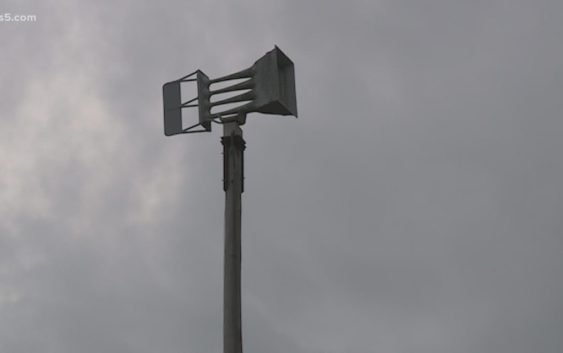- David & Nicole Tepper increase Hurricane Helene relief commitment to $750k
- David & Nicole Tepper increase Hurricane Helene relief commitment to $750k
- McDowell County wildfire spreads to 500 acres, evacuation orders in place
- Evacuations in Caldwell County due to wildfire
- Northwest Houston 'ghost neighborhood' caused by repeated flooding to become latest detention basin
Why San Antonio doesn't have tornado sirens

Sirens in Seguin warned residents of a tornado Monday. If a similar storm formed in Bexar County, San Antonio would be quiet.
SAN ANTONIO — Even after a confirmed a string of tornados tore through Texas Monday, Bexar County officials say it wouldn’t be practical to install an outdoor warning system in San Antonio.
Neither the city nor the county currently use tornado sirens.
Michael Morlan, deputy chief for the Bexar County Office of Emergency Management, said his department does not use an outdoor warning system for the same reason it doesn’t keep snow plows.
“We try to focus on hazards that (pose) the highest risk for us locally,” said Michael Morlan, deputy chief for the Bexar County Office of Emergency Management. “Tornados just aren’t on that list.”
The county conducts a risk assessment every five years to determine what alert systems are necessary.
Morlan said tornados do not occur frequently enough in Bexar County to justify installing a siren network.
“They do happen. I’m not saying they don’t,” he said. “But we don’t get the massive, mile-wide destructive tornados they get up in the Midwest.”
Austin and Houston do not use outdoor warning systems, either.
Dallas, which sits on the southern edge of ‘Tornado Alley,’ operates 168 sirens.
“The type of climate we have here in southern Texas is significantly different… than Dallas-Fort Worth,” Morlan said.
Morlan noted that outdoor warning systems are not meant for residents who are already inside their homes. Instead, they are designed to push people who are outdoors to shelter.
For this reason, college campuses and military installations often maintain their own outdoor warning systems. The University of Texas at San Antonio has eight siren towers on its main campus, for example.
San Antonio Fire Department spokesperson Joe Arrington said outdoor warning systems are most useful in agricultural communities, where workers need more time to get indoors.
Since most San Antonio residents do not work outside, Arrington said the city’s emergency management team can reach a broader audience with targeted cell phone alerts than it could with sirens.
The city’s wireless alert system is robust. Dispatchers can send notifications, like Amber Alerts, to smartphones in a specific neighborhood or ZIP code.
Morlan encouraged people who receive alert notifications to check on their neighbors, especially if they do not have access to the internet or a cell phone.
Most Bexar County residents are probably more concerned about flooding than tornados, Arrington added.
Helotes operates a single siren to alert residents of rising water in high-risk areas. Leon Valley uses two sirens for the same purpose.
Monday’s storm did not kill anyone in southern Texas, though one person died during severe weather in northern Texas.
Guadalupe County’s 23-siren outdoor warning system sounded moments before a confirmed tornado formed in the area.
More than ten confirmed tornados touched down in Texas, as a line of storms moved through the region.
Gov. Greg Abbott said it is a “miracle” that no one died around Houston county.
The same system destroyed homes and killed at least one person in the New Orleans area Tuesday night.